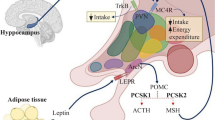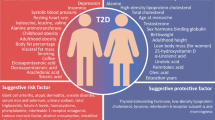Abstract
Upstream transcription factor 1 (USF1) regulates the expression of many genes involved in lipid and glucose metabolism, among them genes regulating lipolysis. USF1 specifically regulates the expression of the hormone-sensitive lipase gene (HSL) in adipocytes and the hepatic lipase gene (LIPC) in the liver, which was found to be involved in liver fat accumulation. The usf1s1 C > T and usf1s2 G > A single-nucleotide polymorphisms (SNPs) in USF1 are associated with increased in vitro catecholamine-induced lipolysis in adipocytes. We investigated first whether SNPs in USF1 affect the lipolysis-suppressing action of insulin in vivo, and second, whether they interact with the −60C > G SNP in HSL on lipolysis and the −514C > T SNP in LIPC on liver fat. The usf1s1 C > T and usf1s2 G > A SNPs, together with the SNPs in HSL and LIPC, were determined in 407 Caucasians. Lipolysis was estimated as a change in free fatty acid (FFA) levels from baseline to 2 h of a 75-g oral glucose tolerance test (OGTT). Fifty-four subjects had data from a euglycemic hyperinsulinemic clamp with calculation of antilipolytic insulin sensitivity. Subjects carrying the minor alleles (T of usf1s1 and A of usf1s2) had lower 2 h FFA (p = 0.01) and a larger decrease in FFA concentrations during the OGTT (p = 0.02). Antilipolytic insulin sensitivity was higher in these individuals (p = 0.03). No interaction of the usf1s1 C > T and usf1s2 G > A SNPs with the −60C > G SNP in HSL on antilipolytic insulin sensitivity was detected. Liver fat, measured by 1H magnetic resonance spectroscopy, was elevated only in subjects who were both homozygous for the major alleles of usf1s1 and usf1s2 and carriers of the T allele of the −514C > T SNP in LIPC (p = 0.01). In conclusion, subjects carrying the T allele of SNP usf1s1 and the A allele of SNP usf1s2 have a higher antilipolytic insulin sensitivity. Moreover, both SNPs may interact with the −514C > T SNP in LIPC to determine liver fat.


Similar content being viewed by others
References
Vallet VS, Casado M, Henrion AA, Bucchini D, Raymondjean M, Kahn A, Vaulont S (1998) Differential roles of upstream stimulatory factors 1 and 2 in the transcriptional response of liver genes to glucose. J Biol Chem 273:20175–20179
Smih F, Rouet P, Lucas S, Mairal A, Sengenes C, Lafontan M, Vaulont S, Casado M, Langin D (2002) Transcriptional regulation of adipocyte hormone-sensitive lipase by glucose. Diabetes 51:293–300
Travers MT, Vallance AJ, Gourlay HT, Gill CA, Klein I, Bottema CB, Barber MC (2001) Promoter I of the ovine acetyl-CoA carboxylase-alpha gene: an E-box motif at −114 in the proximal promoter binds upstream stimulatory factor (USF)-1 and USF-2 and acts as an insulin-response sequence in differentiating adipocytes. Biochem J 359:273–284
Pajukanta P, Lilja HE, Sinsheimer JS, Cantor RM, Lusis AJ, Gentile M, Duan XJ, Soro-Paavonen A, Naukkarinen J, Saarela J, Laakso M, Ehnholm C, Taskinen M-R, Peltonen L (2004) Familial combined hyperlipidemia is associated with upstream transcription factor 1 (USF1). Nat Genet 36:371–376
Coon H, Xin Y, Hopkins PN, Cawthon RM, Hasstedt SJ, Hunt SC (2005) Upstream stimulatory factor 1 associated with familial combined hyperlipidemia, LDL cholesterol and triglycerides. Hum Genet 117:444–451
Naukkarinen J, Gentile M, Soro-Paavonen A, Saarela J, Koistinen HA, Pajukanta P, Taskinen MR, Peltonen L (2005) USF1 and dyslipidemias: converging evidence for a functional intronic variant. Hum Mol Genet 14:2595–2605
Putt W, Palmen J, Nicaud V, Tregouet D-A, Tahri-Daizadeh N, Flavell DM, Humphries SE, Talmud PJ (2004) Variation in USF1 shows haplotype effects, gene:gene and gene:environment associations with glucose and lipid parameters in the European Atherosclerosis Research Study II. Hum Mol Genet 13:1587–1597
Hoffstedt J, Rydén M, Wahrenberg H, van Harmelen V, Arner P (2005) Upstream transcription factor-1 gene polymorphism is associated with increased adipocyte lipolysis. J Clin Endocrinol Metab 90:5356–5360
Komulainen K, Alanne M, Auro K, Kilpikari R, Pajukanta P, Saarela J, Ellonen P, Salminen K, Kulathinal S, Kuulasmaa K, Silander K, Salomaa V, Perola M, Peltonen L (2006) Risk alleles of USF1 gene predict cardiovascular disease of women in two prospective studies. PLoS Genet 2:e69
Casado M, Vallet VS, Kahn A, Vaulont S (1999) Essential role in vivo of upstream stimulatory factors for a normal dietary response of the fatty acid synthase gene in the liver. J Biol Chem 274:2009–2013
Ribeiro A, Pastier D, Kardassis D, Chambaz J, Cardot P (1999) Cooperative binding of upstream stimulatory factor and hepatic nuclear factor 4 drives the transcription of the human apolipoprotein A-II gene. J Biol Chem 274:1216–1225
Pastier D, Lacorte JM, Chambaz J, Cardot P, Ribeiro A (2002) Two initiator-like elements are required for the combined activation of the human apolipoprotein C-III promoter by upstream stimulatory factor and hepatic nuclear factor 4. J Biol Chem 277:15199–15206
Yang XP, Freeman LA, Knapper CL, Amar MJ, Remaley A, Brewer HB Jr, Santainarina-Fojo S (2002) The E-box motif in the proximal ABCA1 promoter mediates transcriptional repression of the ABCA1 gene. J Lipid Res 43:297–306
Iynedjian PB (1998) Identification of upstream stimulatory factor as transcriptional activator of the liver promoter of the glucokinase gene. Biochem J 333:705–712
Botma G-J, van Deursen D, Vieira D, van Hoek M, Jansen H, Verhoeven AJ (2005) Sterol-regulatory-element binding protein inhibits upstream stimulatory factor-stimulated hepatic lipase gene expression. Atherosclerosis 179:61–67
Bensadoun A, Berryman DE (1996) Genetics and molecular biology of hepatic lipase. Curr Opin Lipidol 7:77–81
Santamarina-Fojo S, Haudenschild C, Amar M (1998) The role of hepatic lipase in lipoprotein metabolism and atherosclerosis. Curr Opin Lipidol 9:211–219
Guerra R, Wang J, Grundy SM, Cohen JC, Guerra R, Wang J, Grundy SM, Cohen JC (1997) A hepatic lipase (LIPC) allele associated with high plasma concentrations of high density lipoprotein cholesterol. Proc Natl Acad Sci USA 94:4532–4537
Deeb SS, Peng R (2000) The C-514T polymorphism in the human hepatic lipase gene promoter diminishes its activity. J Lipid Res 41:155–158
Tahvanainen E, Syvanne M, Frick MH, Murtomaki-Repo S, Antikainen M, Kesaniemi YA, Kauma H, Pasternak A, Taskinen MR, Ehnholm C (1998) Association of variation in hepatic lipase activity with promoter variation in the hepatic lipase gene. The LOCAT Study Investigators. J Clin Invest 101:956–960
Arai Y, Hirose N, Yamamura K, Nakazawa S, Shimizu K, Takayama M, Ebihara Y, Homma S, Gondo Y, Masui Y, Inagaki H (2003) Deficiency of choresteryl ester transfer protein and gene polymorphisms of lipoprotein lipase and hepatic lipase are not associated with longevity. J Mol Med 81:102–109
Pihlajamaki J, Karjalainen L, Karhapaa P, Vauhkonen I, Taskinen MR, Deeb SS, Laakso M (2000) G-250A substitution in promoter of hepatic lipase gene is associated with dyslipidemia and insulin resistance in healthy control subjects and in members of families with familial combined hyperlipidemia. Arterioscler Thromb Vasc Biol 20:1789–1795
Jansen H, Waterworth DM, Nicaud V, Ehnholm C, Talmud PJ (2001) EARS-II Study Group. Interaction of the common apolipoprotein C-III (APOC3 −482C > T) and hepatic lipase (LIPC −514C > T) promoter variants affects glucose tolerance in young adults. European Atherosclerosis Research Study II (EARS-II). Ann Hum Genet 65:237–243
Todorova B, Kubaszek A, Pihlajamaki J, Lindstrom J, Eriksson J, Valle TT, Hamalainen H, Ilanne-Parikka P, Keinanen-Kiukaanniemi S, Tuomilehto J, Uusitupa M, Laakso M (2004) Finnish Diabetes Prevention Study: the G-250A promoter polymorphism of the hepatic lipase gene predicts the conversion from impaired glucose tolerance to type 2 diabetes mellitus: the Finnish Diabetes Prevention Study. J Clin Endocrinol Metab 89:2019–2023
Shuldiner AR, Hoppman N, Pollin TI (2004) Hepatic lipase genotype, diabetes risk, and implications for preventative medicine. J Clin Endocrinol Metab 89:2015–2018
Stefan N, Schäfer S, Machicao F, Machann J, Schick F, Claussen CD, Stumvoll M, Haring HU, Fritsche A (2005) Liver fat and insulin resistance are independently associated with the −514C > T polymorphism of the hepatic lipase gene. J Clin Endocrinol Metab 90:4238–4243
Stumvoll M, Wahl HG, Löblein K, Becker R, Volk A, Renn W, Jacob S, Häring H (2001) A novel use of the hyperinsulinemic–euglycemic clamp technique to estimate insulin sensitivity of systemic lipolysis. Horm Metab Res 33:89–95
Stumvoll M, Wahl HG, Loblein K, Becker R, Machicao F, Jacob S, Häring H (2001) Pro12Ala polymorphism in the peroxisome proliferator-activated receptor-gamma2 gene is associated with increased antilipolytic insulin sensitivity. Diabetes 50:876–881
Matsuda A, DeFronzo R (1999) Insulin sensitivity indices obtained from oral glucose tolerance testing. Diabetes Care 22:1462–1470
Laws A, Hoen HM, Selby JV, Saad MF, Haffner SM, Howard BV (1997) Differences in insulin suppression of free fatty acid levels by gender and glucose tolerance status. Relation to plasma triglyceride and apolipoprotein B concentrations. Insulin Resistance Atherosclerosis Study (IRAS) Investigators. Arterioscler Thromb Vasc Biol 17(1):64–71
Sumner AE, Kushner H, Sherif KD, Tulenko TN, Falkner B, Marsh JB (1999) Sex differences in African-Americans regarding sensitivity to insulin’s glucoregulatory and antilipolytic actions. Diabetes Care 22:71–77
Tregouet DA, Escolano S, Tiret L, Mallet A, Golmard JL (2004) A new algorithm for haplotype-based association analysis: the Stochastic-EM algorithm. Ann Hum Genet 68:165–177
Reynisdottir S, Eriksson M, Angelin B, Arner P (1995) Impaired activation of adipocyte lipolysis in familial combined hyperlipidemia. J Clin Invest 95:2161–2169
Båvenholm PN, Pigon J, Östenson CG, Efendic S (2001) Insulin sensitivity of suppression of endogenous glucose production is the single most important determinant of glucose tolerance. Diabetes 50:876–881
Gibson F, Hercberg S, Froguel P (2005) Common polymorphisms in the USF1 gene are not associated with type 2 diabetes in French Caucasians. Diabetes 54:3040–3042
Ng MC, Miyake K, So WY, Poon EW, Lam VK, Li JK, Cox NJ, Bell GI, Chan JC (2005) The linkage and association of the gene encoding upstream stimulatory factor 1 with type 2 diabetes and metabolic syndrome in the Chinese population. Diabetologia 48:2018–2024
Lee JC, Lusis AJ, Pajukanta P (2006) Familial combined hyperlipidemia: upstream transcription factor 1 and beyond. Curr Opin Lipidol 17:101–109
Acknowledgments
We thank all the research volunteers for their participation. We gratefully acknowledge the superb technical assistance of Anna Bury, Heike Luz, Melanie Weisser, Alke Guirguis, and Claudia Peterfi.
The studies were supported by a grant from the Deutsche Forschungsgemeinschaft (KFO 114/1) and the European Community’s FP6 EUGENE6 (LSHM-CT-2004-512013).
Author information
Authors and Affiliations
Corresponding author
Rights and permissions
About this article
Cite this article
Kantartzis, K., Fritsche, A., Machicao, F. et al. Upstream transcription factor 1 gene polymorphisms are associated with high antilipolytic insulin sensitivity and show gene–gene interactions. J Mol Med 85, 55–61 (2007). https://doi.org/10.1007/s00109-006-0105-x
Received:
Accepted:
Published:
Issue Date:
DOI: https://doi.org/10.1007/s00109-006-0105-x




